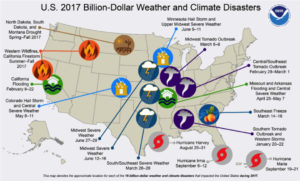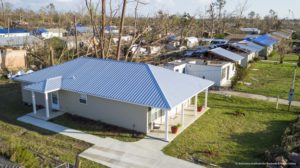The future looks ominous, but for emergency managers, it always has.
Since emergency management emerged as a specialized discipline in the mid-twentieth century, practitioners have always seen a future filled with disasters. Recall that today’s emergency management agencies are descended from Cold War civil defense organizations which were created in response to the terrifying threat of nuclear holocaust.
Thankfully, Nuclear Armageddon seems less likely today, but a look at our future might be only slightly less harrowing. Sea levels are rising, weather patterns are changing, storms are becoming more destructive, our infrastructure is deteriorating, our vulnerability to cyber attacks is increasing, federal funding for emergency management is almost certain to decline, our population is aging, more people are choosing to live in disaster-prone areas, and economic inequality and political tribalism are driving a wedge through the hearts of our communities.
Our problems are getting worse and our ability to address them is declining.

Graphic from https://www.climate.gov/news-features/blogs/beyond-data/2017-us-billion-dollar-weather-and-climate-disasters-historic-year
But we are not powerless in the face of these threats. We can, in fact, take action today to improve our community’s ability to respond to future disasters of all types – including destructive weather, technological accidents, terror attacks, pandemics, income inequality, job losses, and other long or short-term hazards. As emergency mangers we can take the lead in building community resilience.
Building resilience is not a new idea, but for most communities it will require a shift in perspective, a focused educational campaign, and an unwavering commitment from community leaders. And emergency managers are perfectly positioned to lead the way.
What is Resilience?
Resilient communities recover from disaster faster, more completely, and more efficiently than less resilient communities. When recovering from disaster, they don’t just replace what was lost, they build a stronger community that is better prepared for future disasters. Before disaster strikes, they focus on the future and they anticipate future risks. They understand their strengths and weaknesses, they learn from their mistakes, and they correct them. They are well-governed, well-connected, and they are backed by a diverse and solid local economy. Most importantly, they create a culture of collaboration, they strengthen community ties, and they act with a sense of purpose and urgency.
Resilience encompasses every aspect of a community’s life. Infrastructure, social capital, community cohesion, geography, demographics, mitigation, preparedness, planning, and the strength of the local economy all determine how effectively a community can adapt to chronic and acute stresses. Some people equate resilience with preparedness, but resilience is much broader. While disaster preparedness is certainly part of resilience, it is only one part of many. Resilient communities are prepared, but prepared communities are not necessarily resilient.
Resilient communities aren’t problem-free. But when problems arise, community members identify the root causes, come together to develop community-wide solutions, and cooperate to address those causes. Residents of resilient communities are confident in their ability to come together to solve problems and create a strong, vibrant community that works for all of its members.
A large-scale disaster will be a huge problem for any community. But resilient communities that have experienced success in handling lesser problems will have the confidence and skills to recover quickly and completely from natural and man-made disasters. Resilient communities are less vulnerable, suffer less damage from disasters, recover faster, require less outside assistance, and are better places to live. For emergency managers, resilience is a force-multiplier.

This affordable house, built under the “Habitat Strong” program, is one of six that survived Hurricane Michael unscathed. Surrounding older homes show severe roof damage.
(Photo credit: Journal of Light Construction: https://www.jlconline.com/projects/disaster-resistant-building/surviving-hurricane-habitat-houses-offer-lessons_o)
FEMA and the National Emergency Management Association (NEMA) both recognize the value of resilience. FEMA has a Resilience Directorate that combines mitigation administration, continuity programs, grant programs, federal insurance administration, and national preparedness. FEMA also offers an eight-hour course on building resilience (AWR-228: Community Resilience). NEMA and the U.S. Department of Homeland Security (DHS) are collaborating on a project to improve community resilience through enhanced risk assessments, information sharing, planning, mitigation, recovery efforts, and investments. Other organizations that provide guidance for communities seeking to build resilience include the Global Resilience Institute (GRI) at Northeastern University, 100 Resilient Cities, and Resilient Communities For America.
The Role of Emergency Managers
But if the keys to resilience are good governance, a strong economy, community connections, committed leadership, a culture of collaboration, and a healthy and prosperous population, how much impact can emergency managers have? These issues are far beyond the responsibilities or resources of emergency management agencies.
A large impact, actually. Emergency managers are remarkably well-positioned to lead community-wide efforts at building resilience. Emergency managers are recognized experts in mitigation, preparedness, response, and disaster recovery planning – the foundation of resilience. In addition, emergency managers are experienced at working with people from multiple agencies and multiple disciplines; have a regional perspective; understand the concept of the whole-community; and are experienced at conducting large-scale public education campaigns.
By virtue of their professional knowledge, their position in the community, and their experience, emergency managers are perfectly suited to start, sustain, and shape a community-wide conversation about resilience.
Building Resilience
Like preparedness, there is no resilience end state, no point where an emergency manager can say, “Today we achieved resilience.” Instead, there is a spectrum of resilience, and every community sits somewhere on the line between ‘less resilient’ and ‘more resilient.’ Your community’s task, then, is not to achieve resilience, but to become more resilient. Since there is no resilience end state, there is no end to the process of building resilience. Creating a more resilient community requires a never-ending commitment to consider the impact on resilience of virtually every community investment decision. Each proposal for a new housing development or commercial building; for upgrades to water, sewer, or transportation systems; for updated building or zoning codes; or for new social programs is an opportunity to increase community resilience.
Failing to take advantage of these opportunities will not only slow progress towards greater resilience, it may actually push a community towards the ‘less resilient’ end of the spectrum.
Building resilience takes the whole community and it must be consciously pursued all the time. While specific initiatives like infrastructure hardening or disaster-resistant building codes can increase community resilience, the total effort must be holistic, synthesizing political, economic, and social improvements to create a stronger community.
A community that wants to increase resilience must have four key attributes: committed leadership, a shared vision, a culture of collaboration, and a sense of urgency.
Here are seven things emergency managers can do to help their communities become more resilient:
- Understand the problem: Learn all you can about resilience and how it can help your community. Review current research and review the websites of organizations that promote resilience.
- Complete a community risk assessment. Your community may already have a regional risk assessment, like a Threat and Hazard Identification and Risk Assessment (THIRA). If not, you will need to produce one. A risk assessment and gap analysis will provide accurate baseline information to inform later resilience planning. Your assessment should identify your community’s threats, vulnerabilities, capabilities, and any capability gaps.
- Educate your own organization. Start your resilience-building project by convincing the leaders of your own organization of the benefits of community resilience. If your own organization does not fully embrace the project, it will be very difficult to convince others.
- Introduce the concept to the community. Educate key community leaders and residents about the importance of resilience, how it will benefit your community, and how your community can become more resilient. Schedule one-on-one meetings, speak to groups and include resilience planning in your public outreach messaging. Your goal should be to build consensus, create allies, and, if possible, identify a key leader who can champion the effort.
- Bring stakeholders together. Organize a workshop, seminar, or other event to bring community stakeholders together to begin the process of building resilience. Representatives from all sectors, including government, non-governmental organizations, regional agencies, educational institutions, community groups, faith-based organizations, critical infrastructure operators, and business leaders should be invited.
- Create a formal resilience planning organization. This group should be responsible for developing the community’s shared vision and managing the resilience planning project. This organization may require a full-time chairperson.
- Create and maintain a sense of urgency. This is a long-term project that will not produce fast results. Maintain community interest and energy by continually supporting resilience-building efforts.
Final Thoughts
Building resilience requires a never-ending, concerted effort by all elements of the community, but the results will benefit every resident and organization. As an emergency manager, you can play a key role in starting, shaping, and sustaining your community’s effort to build resilience.
July 22, 2019
This article was originally published in the August 2019 edition of the International Association of Emergency Manager’s online Bulletin: https://www.iaem.org/LinkClick.aspx?fileticket=3LXHvwqlMYk%3d&portalid=25
Title image:
Satellite imagery of the US Atlantic Coast with Hurricane Dorian in the morning of 2 September 2019
(Photo credit: NOAA)
